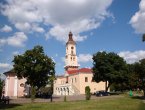ChernivtsiChernivtsi is the administrative centre of Chernivtsi region in western Ukraine. The city is situated on the upper course of the River Prut, a tributary of the Danube. Chernivtsi is the biggest city of historic region of Bukovina, which nowadays is divided between Romania and Ukraine.
 Chernivtsi is a city with a long and vary fascinating history. A fortified settlement on the left shore of the Prut River was built in XII century. The fortress-city became the subject of legend. The blackened appearance of oak, covered with chornozem, which was used for the city walls, resulted in the nickname “the Black City”. Chernivtsi is a city with a long and vary fascinating history. A fortified settlement on the left shore of the Prut River was built in XII century. The fortress-city became the subject of legend. The blackened appearance of oak, covered with chornozem, which was used for the city walls, resulted in the nickname “the Black City”.
Chernivtsi is a beautiful green city which saved through ages a wonderful architecture. The city is famed for its palaces, temples and dwelling houses. There are many architectural monuments of the European level here, erected in 12-13 centuries. Chernivtsi is called the symbiosis of the architectural monuments which are nowadays the architectural adorning of Vienna, Prague and Paris.
 The main attraction of the city is the National University of Chernivtsi. The building was projected by the Czech scientist and architect Iosef Glavka. The wooden St. Nikolai Church, built in 1607 and remained up to nowadays is situated on the Sagaidachna Street. St. Nikolai Church is the oldest construction in the city. Tourists can also admire in Chernivtsi the General’s House, the St. Paraskevia Church, and the Roman Catholic Church of the Holy Cross, the tower of which was used as the observation point to find the fire. The main attraction of the city is the National University of Chernivtsi. The building was projected by the Czech scientist and architect Iosef Glavka. The wooden St. Nikolai Church, built in 1607 and remained up to nowadays is situated on the Sagaidachna Street. St. Nikolai Church is the oldest construction in the city. Tourists can also admire in Chernivtsi the General’s House, the St. Paraskevia Church, and the Roman Catholic Church of the Holy Cross, the tower of which was used as the observation point to find the fire.
 The Central Square is the heart of Chernivtsi. There are many old but well remained buildings on the square. The most interesting building is the town hall, a 50 m high double-decked tower with balconies on the top of which there are only spire and a clock. The Central Square is the heart of Chernivtsi. There are many old but well remained buildings on the square. The most interesting building is the town hall, a 50 m high double-decked tower with balconies on the top of which there are only spire and a clock.
The Theatre Square is one of the most beautiful in Chernivtsi. The Dramatic Theatre is situated here. Its façade is adorned with the sculptural group associated with the Greek mythology and marble busts of the famous persons of the world culture. |




 Chernivtsi is a city with a long and vary fascinating history. A fortified settlement on the left shore of the Prut River was built in XII century. The fortress-city became the subject of legend. The blackened appearance of oak, covered with chornozem, which was used for the city walls, resulted in the nickname “the Black City”.
Chernivtsi is a city with a long and vary fascinating history. A fortified settlement on the left shore of the Prut River was built in XII century. The fortress-city became the subject of legend. The blackened appearance of oak, covered with chornozem, which was used for the city walls, resulted in the nickname “the Black City”. The main attraction of the city is the National University of Chernivtsi. The building was projected by the Czech scientist and architect Iosef Glavka. The wooden St. Nikolai Church, built in 1607 and remained up to nowadays is situated on the Sagaidachna Street. St. Nikolai Church is the oldest construction in the city. Tourists can also admire in Chernivtsi the General’s House, the St. Paraskevia Church, and the Roman Catholic Church of the Holy Cross, the tower of which was used as the observation point to find the fire.
The main attraction of the city is the National University of Chernivtsi. The building was projected by the Czech scientist and architect Iosef Glavka. The wooden St. Nikolai Church, built in 1607 and remained up to nowadays is situated on the Sagaidachna Street. St. Nikolai Church is the oldest construction in the city. Tourists can also admire in Chernivtsi the General’s House, the St. Paraskevia Church, and the Roman Catholic Church of the Holy Cross, the tower of which was used as the observation point to find the fire. The Central Square is the heart of Chernivtsi. There are many old but well remained buildings on the square. The most interesting building is the town hall, a 50 m high double-decked tower with balconies on the top of which there are only spire and a clock.
The Central Square is the heart of Chernivtsi. There are many old but well remained buildings on the square. The most interesting building is the town hall, a 50 m high double-decked tower with balconies on the top of which there are only spire and a clock.